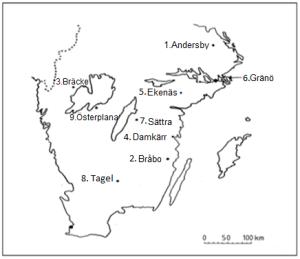Grazing versus mowing trial
Study sites, experimental design and sampling

The effects of grazing and mowing on the grassland vegetation composition was studied in eleven experimental sites at nine locations in southern and central Sweden (two of the sites had two experimental sites each). The sites varied in soil type and nutrient and moisture conditions. The trial was set up in 1973 and ran until 1986 in most sites. Grazing and mowing were applied to two 5 m x 20 m plots per site. The mowing occurred in late July or early August, using a scythe or a knife mower. The grazed plots were grazed by cattle, sheep or horses. The vegetation was surveyed in 1973, 1975, 1980, 1986 and 1987. The surveys took place before mowing and either the entire treatment plot or different number of subplots was surveyed. During the survey plant species were recorded as present/absent, as the percentage coverage of the species or as the coverage of species according to the Hult-Sernander-Du Rietz-scale.
Classification of plants and statistical analysis
To show the effect of the treatments on the grasslands vegetation, the species recorded was classified as grassland indicators according to several different classification systems. The species were classified as indicators of i) good management, ii) excess nitrogen, or iii) lack of management.
As the survey method and number of subplots differed between years and sites, meta-analysis was used to overcome these differences. To compare the effect of grazing and mowing, log odds ratio-analysis was used, which compares the odds of a species being an indicator species with the odds of it being a non-indicator species, between the treatments. The treatment with higher odds of finding indicators of good management and lower odds of finding indicators of excess nitrogen and lack of management would be considered as having a positive effect on the vegetation composition.

Responsible for this page:
Director of undergraduate studies Biology
Last updated:
05/20/13
